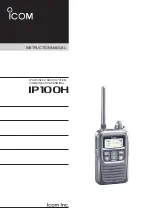
E-51
Uniden MHS335 Radio Owner’s Manual
REGULATIONS AND SAFETY WARNINGS
MARITIME RADIO SERVICES OPERATION
Warning!
This transmitter will operate on channels/frequencies that have restricted use in the
United States. The channel assignments include frequencies assigned for exclusive use of the
U.S. Coast Guard, use in Canada, and use in international waters. Operation on these frequencies
without proper authorization is strictly forbidden. See page E-44 for tables of the available channels
and their uses. If you are still not certain which channels to use, see the FCC maritime radio page at
the FCC website (
http://wireless.fcc.gov/marine/
) or contact the FCC Call Center at 1-888-CALL-
FCC. For individuals requiring a license, such as commercial users, you should obtain a license
application from your nearest FCC field office (for US users) or Industry Canada (for Canadian
users).
BASIC RADIO GUIDELINES
You should familiarize yourself with the rules on marine radios and be aware of which rules apply
to your
ship
. Complete guidelines for all ship and marine radio types can be found at the US Coast
Guard website under the topic Radio Info for Boaters (the direct link is http://www.navcen.uscg.
gov/?pageName=mtBoater. Here are a few guidelines that affect nearly all boaters.
• If you have a VHF radio on your
ship
, you must maintain a watch on channel 16 (156.800 MHz)
whenever the radio is not being used to communicate. Starting in 2004, if a radio is carried, it
must be on and set to channel 16. Wwhenever your
ship
is underway.
• If you hear a distress call, wait a few minutes to let a shore station or Coast Guard
ship
respond. If no other station has responded after 5 minutes, you must respond to the distress
call.
• Do not make false mayday or distress calls as a prank or to test your radio. (This is essentially
like making a false 9-1-1 call; you may be subject to fines.)
FCC/Industry Canada Information
Certification: FCC Part 80 or RSS-182
Output Power: 6W
Emission: 16K0F3E
Transmitter Frequency Range: 156.025-157.425 MHz
This device complies with Part 15 of the FCC Rules. Operation is subject to the condition that this
device does not cause harmful interference.
Unauthorized changes or modifications to this equipment may void compliance with the FCC Rules.
Any change or modification must be approved in writing by Uniden. Changes or modifications not
approved by Uniden could void the user’s authority to operate the equipment.
FCC RF Exposure Information
In August 1996 the Federal Communications Commission (FCC) of the United States with its action
in Report and Order FCC 96-326 adopted an updated safety standard for human exposure to radio
frequency electromagnetic energy emitted by FCC regulated transmitters. Those guidelines are
consistent with the safety standard previously set by both U.S. and international standards bodies.
The design of the radio complies with the FCC guidelines and these international standards.
WARNING! Read this information before using the radio.






































